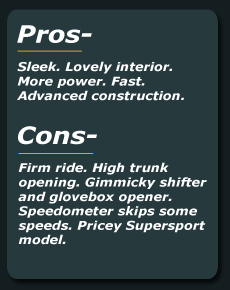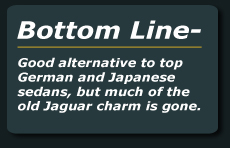2011 Jaguar XJ
Prices: $71,650-$114,150
Jaguar looked at declining sales of its flagship XJ sedan and felt it
was time to drop the car’s retro styling and come up with a
more modern design.
While the 2011 XJ looks sleeker and more muscular than old XJs, it has
a slim, graceful roofline that the automaker says is a
“nod” to the roofline of the original 1968 XJ
sedan, which was a styling masterpiece. Also, although Jaguar makes few
references to old XJ models, the new XJ’s large grille is
reminiscent of the 1968 XJ’s grille.
“The new XJ is a thoroughly modern interpretation of the
quintessential Jaguar,” said Ian Callum, design director for
Jaguar Cars.
Curiously, taillights of the newly designed XJ—first on sale
as a late 2010 model—reminded me of those on
America’s ill-fated 1954 Kaiser sedan.
It’s rather sad that the new XJ four-door has lost much of
the charm of the long series of old XJs, and some people
won’t recognize it as being a Jaguar. You once could tell a
car was a Jaguar from at least a block away.
Jaguar long has provided sumptuous interiors, and the new
XJ’s quiet, roomy leather-and-wood interior is among the best
among luxury sedans. It has ultra-modern gauges, but also a retro
analog clock with individual chrome chaplets, a spun metal face and an
iridescent blue background—a look inspired by luxury watches.
A standard, panoramic glass roof enhances the interior
feelings of light and space.
But the speedometer skips some mph readings. That is, it
reads “10,” “30,”
“50,” etc. You have to guess where
“20,” “40” and some other mph
readings come in.
The gimmicky console shifter is a round dial that raises slightly from
a flush position on the console and calls on a driver to turn it to the
right or left to select such positions as “P” or
“D.” Also, the glove compartment calls a hand to be
waved in front of it to cause it to open—a silly procedure
that doesn’t always work the first, second or third
time.
However, the new XJ is generally gadget-free, with no features such as
night-vision or lane-maintaining assists. However, useful safety
features such as dynamic stability control are standard.
The 2011 XJ is sold in standard XJ and longer-wheelbase XJL forms. The
XJL offers almost limo-style rear passenger space, providing an
additional five inches of rear legroom. Still, the center of the rear
seat is too hard for comfort and best left to a fold-down armrest,
which contains cupholders..
All versions are very well-equipped with luxury car comfort,
convenience and safety items.
Prices--excluding an $850 freight charge—range from $71,650
for the entry 385-horsepower regular wheelbase XJ ($78,650 for the
long-wheelbase version) to $114,150 for the over-the-top supercharged
long-wheelbase 510-horsepower Supersport XJL. The Supersport has such
items as power heated active/massage ventilated sports seats, wireless
headphones and a 20-speaker sound system with rear audio controls.
In between is a supercharged 470-horsepower model, priced at $86,650 to
$89,650.
I tested the 385-horsepower XJL, which should be fine for most XJ
buyers. (0-60 mph in 5.4 seconds). This model is expected to account
for most XJ sales in America.
All versions share a smooth, advanced 5-liter V-8, hooked to a
responsive six-speed automatic transmission with a fully adaptive shift
system. It works so well there’s little reason to use its
“manumatic” manual-shift feature.
While the new XJ feels heavy, it uses Jaguar’s
aerospace-inspired aluminum body technology, which makes it at least
300 pounds lighter, compared to steel body construction. Still, this is
a big sedan, so it weighs 4,050 to 4,350 pounds.
Fuel economy thus isn’t a high point. Even the 385-horsepower
V-8 only delivers an estimated 15 mpg in the city and 22 on highways.
Jaguar is perhaps best known for its sports cars, but no XJ ever was
that type car. Still, the latest XJ is sporty enough to be appreciated
by good drivers. Steering is quick and progressive, and the car handles
adroitly, although the weight can be felt during fast maneuvers. The
suspension may be a little firm for some luxury car buyers or drivers
of older XJS, but the ride isn’t harsh. The brake pedal has a
linear feel, and the anti-lock brakes are strong.
The trunk is large, but rather shallow, and has a high-but-wide,
opening.
The hood raises on twin struts, revealing a large, plastic engine
cover. Jaguar engines once weren’t covered and looked like
nice pieces of sculpture, but those days are gone.
No doubt the new XJ is the best ever, but something is missing.














